November 18th, 2010
| 5 Comments »
There’s a lot of cowboy in me. Not the horse-ridin’ spur-wearin’ giddy-up-ing cowboy, but the kind that understands ‘Cowboy Cooking’ as a necessary culinary term.
Most people these days better understand the term ‘Iron Chef’ though, thanks to the ubiquitous presence of the Food Network. Cowboy cooking, or Iron Chef-ing is where you take a whole bunch of ingredients and come up with a dish that is nothing short of fantastic. It’s a skill that has served me well in my kitchen.
This roasted vegetable pasta dish was a stellar example of that. It’s from last winter and was a repeated entree in our kitchen for the remainder of the season. All you do is roast up a pan of your favorite vegetables until they are fragrant and soft, then process them in a food processor to a chunky sauce. Mix them with a hefty pasta shape, add some grated parmesan and grab your fork. It works equally well to just toss them with pasta as is after roasting.
The sauce is versatile enough to also be used as an appetizer, topping crostini or another sturdy base.
And uh yeah….. ew; this photo is NOT my favorite, yet it’s what I get trying to photograph food in Minnesota during the month of February. Ugh. Sorry.

It really tastes FAR better than this looks. I promise! Yee haw!! Let’s get cookin’!
Roasted Vegetable Pasta
1 medium eggplant, cubed
1 medium yellow onion, cut into eighths
1 red pepper, seeded cored and cut into large chunks
1 pint grape tomatoes, halved
4-6 cloves garlic, rough chopped into large pieces
Olive oil
Salt and pepper
1 # rigatoni
Fresh parmesan cheese
Chopped kalamata olives
Place vegetables into a large bowl. Pour about 1/8 c. of olive oil over them, salt and pepper and maybe some dried seasoning of your choice. Toss to coat. Place on cookie sheets and roast in a 400-degree oven for 25-35 minutes, or until vegetables are soft and fragrant. Gently stir once during the cooking.
Cook pasta to al dente. Drain, reserving about 2 cups of pasta water and keep pasta warm. Place roasted vegetables in food processor and add a cup of reserved pasta water and 1/8 c. olive oil. Process until mixture is chunky, scrape down sides and process to desired consistency. If mix is too thick, add some more pasta water. You want it to be spreadable but not drippy, thick but not gloppy.
Toss vegetable mix with warm pasta. You may not need it all so scoop accordingly. Toss to coat pasta, add in kalamata olives (if desired) and parmesan cheese. Season with salt and pepper. Serve hot.
And remember when I recently talked about that yummy Panko Crumb topping? Hello, and giddyup …..it works perfect here.
August 1st, 2010
| 4 Comments »
As I write this, my boy is somewhere on the road between our home and the Southeastern USA, traveling across four states with his student leadership group from our church for a week-long missions trip to an impoverished area in the southern part of West Virginia. The road trip will take two days before they arrive at their destination.
My boy has been away before, so this is nothing new, this being gone for a week at a time. He’s been spending part of the past 8 summers away, and he always enjoys it. He has to; he was never given the luxury of having a choice in the matter. Being an only child, he was pushed away from my side by necessity. I couldn’t hover, I couldn’t at all. He had to learn to play by himself, read by himself, entertain himself and sleep by himself. And he didn’t have the advantage of siblings to soften any landing that occurred in his life. He was the baby bird on the limb, Mama coaxing him out of the nest at a tender young age and for the most part, he’s done well with those landings. He’s comfortable being away from me, and this is a good thing. Because I know that when he’s ready to fly and really spreads his wings, that he will soar mightily. And I am thrilled and excited to see where this missions trip will take him, in his walk with his Faith, and in his life. He’s had it good, this boy of mine. A dose of reality that life isn’t always kind, that homes aren’t always luxurious and comfortable and that a meager way of life happens to even the kindest people. We all need that perspective shift sometimes to keep us grounded and real.
When I dropped him off with his group and drove off, I expected some jubilation. I expected a slight sigh of relief for a quiet house and no chauffeur duties in the week ahead, meals planned for Mike and I and no one texting me to bring home ice cream as I am getting off work. What I got was something completely unexpected. I was wracked with worry. Because for now, until the team lands at their final destination, I have no clue what’s happening and I have to put an enormous amount of faith in the process. He is in good hands, the team leaders are amazing adults, with soft hearts and strong spirits. He will be safe with them. But there is a long, long and open road that they are on, one that isn’t always so friendly. Or protective. Two vans, one large trailer, and a laughing, wonderful group of incredible young men and women all in high spirits for the adventure that awaits. The thought of anything disastrous happening to them haunts me. And surprises me too. I didn’t expect this feeling, but I don’t doubt it’s validity. That’s my boy. It’s a piece of my heart on that road between here and the South. If I wasn’t worried just a little, that in itself would be worrisome. So I trust, and I remember to breathe. And to pray for them all. Especially those behind the wheel.
And so the expected excitement of sending him off and a week with my spouse has been replaced with this Mama’s heart, and a need to comfort myself. With an abundance of fresh blueberries on hand, a warm muffin seemed perfect. But like this unexpected shift in my day, my favorite recipe was lacking in one very important ingredient and for a moment I actually felt like I had no energy to punt and see what happened. Most of my recipes are sort of like Hail Mary passes, or the punt that will win the game. I close my eyes, do what needs to get done and hope for the best. It’s like craving lemonade when faced with oranges, or planning the trip of a lifetime only to get diverted to a different destination.
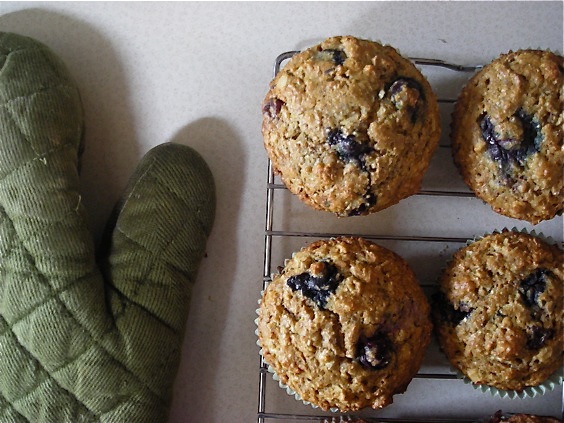
Or like this particular morning, wanting bran muffins with fresh blueberries, and ending up with something more like oatmeal. It’s reaching for dried cherries to add some flavor, and dumping what was left of some crushed almonds into the batter to use them up. It meant adding some yogurt to regular milk to create a buttermilk-like tang. More importantly, it meant drowning out the recurring voice in my head that left me lost and empty. The task of making a simple muffin, with necessary improvising, took away the worry. And the result was both peace of mind, with a side of oh-so-very-delicious.

Kate’s Blueberry Bran Muffins
Heat oven to 425°. Prepare muffins tins with cooking spray, or liners.
Mix together in a large bowl:
1-1/2 c. All Bran Cereal
1/2 c. whole rolled oats
1-1/2 c. buttermilk
2 eggs, lightly beaten
1/4 c. melted butter
1/4 c. olive oil
1/4 c. maple syrup
Allow mixture to sit for 10-15 minutes, until softened.
In a separate bowl, whisk together:
3/4 c. unbleached AP flour
3/4 c. whole wheat flour
2 T. ground flaxseed
1/4 c. brown sugar
1 t. baking soda
1 t. baking powder
1/2 t. sea salt
When bran mixture is soft, gently stir in the flour mixture only until just incorporated. At this point, add a cup of frozen blueberries and gently fold them in. Scoop into prepared muffin pans and bake for 20-25 minutes, or until toothpick inserted in center comes out clean. Cool in pan for 10 minutes, then remove to wire cooling rack.
KATE’S NOTES: If you don’t have All Bran cereal on hand, you can use all oatmeal in the first step. Another option to use would be a commercial multi-grain hot cereal mix like Bobs Red Mill 7-Grain or 10-Grain for the All-Bran. I’ve done this both ways and the results are always delicious. The ground flaxseed is my addition. Leave it out if you don’t have it on hand. And you can use all white flour, or all wheat flour for these if you wish.
To sub for buttermilk, you can use the lemon juice/vinegar option (1 t. either juice or vinegar per 1 c. liquid, stir together then allow to sit for 10 minutes to curdle) or you can mix about 1/3 c. of plain or vanilla yogurt into 1-1/2 c. of plain milk, or even soy milk. I use soy milk, and love how the added yogurt gives it some extra moisture.
Some dried fruit is a nice addition to these; you can use apricots, cherries, figs, dates or prunes. Mince about a 1/2 c. of your preferred fruit and add it to the cereal mixture in the first step. The soaking in buttermilk softens it greatly, and it almost melts in the oven leaving tiny, tangy sweet pockets in your muffins. And adding in 1/3 to 1/2 c. of your choice of chopped nuts also makes for a fine addition.
June 13th, 2010
| 13 Comments »
I often wonder whose idea it was to make Fish Tacos.

Fish. In a taco. That overloaded, cheese filled Tex-Mex staple. dripping with seasoned meat and shredded iceberg. At one point, someone thought to push a few pieces of fried and lightly seasoned mild fish into a flour tortilla and call it a meal. Now it’s everywhere and people just love them.
Problem is, they ARE everywhere, and often not done all that well. The fish is almost always fried, which yes, makes it crunchy and appealing and all, but certainly not very healthy. This is fish. It’s good for the body when done right. I’ve tried numerous offerings of fish tacos, eagerly anticipating the. one. that makes it all worthwhile. The epicenter of fish taco-ness that will make me swoon, and want to run home to my own kitchen to replicate.
Friends, it’s never happened. So I took matters into my own hands, in my own kitchen, and made them the way I wish they would always be made.

There’s just nothing to this meal. You need some perfectly ripe avocado, a plump tomato, some form of crunchy vegetable item such as gently seasoned cabbage to offset the tender fish and a simple can of black beans. Oh yes, and fish. I used tilapia but you could also use halibut or cod depending on availability.
And this is fish, which we all know from experience is on the Love-Hate scale in my house. Mike loves it, and Griffin hates it. Or at least he seems to think he hates it. Because this is new to him, in the past few years, this despising fish deal. When he was quite the young boy, in his adorable, always helpful/cheerful/talkative Can I hold your hand, Mom? stage, my boy simply LOVED fish. He denies it now, for certain, but it’s true. I would make fish for dinner and he would light up in the way only small adorable boys can and exclaim “Fish! Yum!” when he pulled out his chair to eat. It was always seared in a pan, never fried, and yes I did give him a blop of tartar sauce to push his fish through, but he would eat it all without one little complaint. How I long for those days.
He’s OK with it now; he’s stopped with the mega-fits when he knows it’s on the dinner menu, but will never ask for it like he does his beloved steak, and I do still keep tartar sauce on hand and allow for him to smear it on his fish as thick as he wishes. He will take the smallest piece possible to get by and eat it, almost holding his breath, only because it’s how we roll at dinnertime here. You eat what’s served or make your own.
Mild, flavorful and fresh beyond belief, these tacos were such a perfect summer meal. Simple too, which these days with my schedule and valued days off, I don’t want to be chained to any time consuming menus, making the few dinners I can put together at home. The weather was gorgeous, and after Mike and I trimmed some over-zealous bushes in our yard and then impulsively chopped a few large tree branches off, dinner was still on the table about a half an hour after we came inside. These fish tacos, with all the ease and flavor, were what I feel a good, healthy fish taco should be.
Fish Tacos
by Kate
1# tilapia filets
1/2 c. flour
1 T. each ground cumin, dry oregano and chili powder (for more convenience, use 3 T. prepared taco seasoning)
For serving: flour tortillas, diced avocado, diced tomato, shredded cabbage or romaine lettuce, drained and rinsed black beans, sour cream and salsa.
Heat a heavy skillet over medium high. Mix the flour and seasonings together. Adjust with salt and pepper if desired and dredge fish in mixture. When skillet is very hot, add a small amount of oil and quickly swirl to coat. Carefully place fish in pan and cook without moving for about 5 minutes. Turn over and cook other side until fish is done and flakes easily, about 5 minutes more. Cooking time is dependent on thickness of filets and will vary.
Top tortillas with hot fish and toppings as desired.
February 22nd, 2010
| 8 Comments »
There are certain foods that are superstars of nutritional value, simple to prepare and easy on the pocketbook yet are really kind of ugly ducklings in terms of aesthetics. If we eat with our eyes first and foremost, and if we didn’t know that these foods were not only powerhouses in being good for us AND very tasty as well, we would take one look at them and likely turn away in scorn. Take lentils for example. These tiny legumes are so rich in the good things we need for our bodies. But I imagine there’s a huge population of people simply turned off by their unfortunate lot in the food world beauty contest. Cooked to perfection and placed in a bowl, they resemble more a pile of mud than something amazing you want to eat.
Now doesn’t that sound delicious?! Can’t wait to dig in!
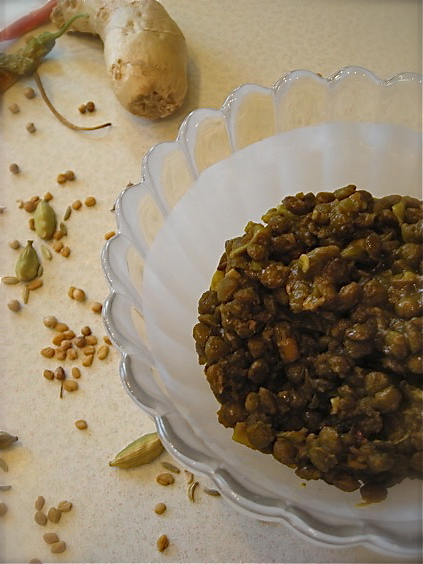
I do get it. Really, I do. If it wasn’t for the copious amounts of fragrant dhals and mounds of aromatic Indian food that I’ve come to adore in my life, I might not exactly be in the Lentil Fan Club. But I am. And I think that everyone should. As legumes go, the lentil is one that you can take from dried form to beautifully cooked with hardly a second thought. Even the largest brown lentils will cook up nicely in about 20-30 minutes, the smaller pink and red ones turn delightfully smooth even faster, making the lentil a smart choice to keep on hand for a hearty meal. With added vegetables, it turns into a perfect soup. Served over rice, maybe with a salad and you’ve got a complete meal. Add in one of the heady fragrant spices of Indian cuisine, such as fenugreek or cumin -or in this case, both- and you’ve got a delicious creamy, slightly spicy and overall compelling meal with little more than boiling some water and a measuring spoon or two.
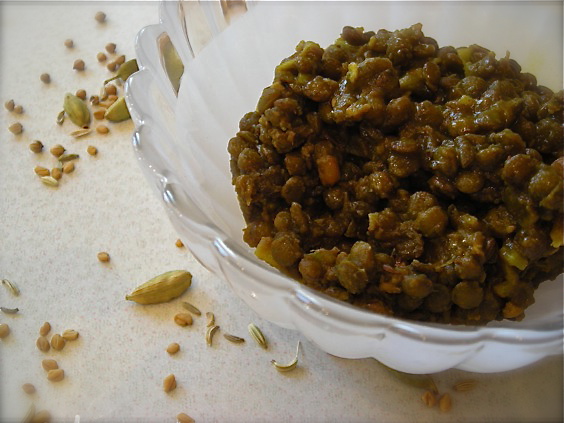
By far and away my favorite lentil is the French Puy, also known as the French Green lentil. It’s smaller than the brown, larger than the more colorful red and pink and will also cook up easily, all the while retaining it’s shape more without turning mushy. While the mushy lentil does have it’s place, I really prefer some texture to them. The Puy has a somewhat higher price tag than the brown, but I think it’s worth it. The flavor too, is deep and earthy, a bit more intense over the somewhat gritty taste I’ve come across in the brown.
My first exposure to lentils was as a wee lass in elementary school. Our schooling, up until I was in 5th grade, centered mostly around a loosely defined cooperative that rented space in an old Catholic school building. We had some pretty progressive education, I guess these days it ties in best with home schooling, and one year we did volunteer work at the Renaissance Festival in a soup booth, making both Beet Borscht and Lentil Soup. I did not like the lentil soup much, but I was a kid. Forgive me for thinking it was odd among my usual repertoire of fish sticks and Rice-a-Roni.
Then in college, I had a roommate for a time who was a vegetarian and loved to cook. On occasion I would tag along with her on her trips to The Wedge Co-Op, back in the long ago days when it was so tiny that barely two people could stand in any aisle. I often had no clue about the foods she would buy but I asked her endless questions and when she cooked she would share some of her meals with me. One meal was lentils, and although I didn’t fall down in love with them, I had a better idea of them than what my childhood memories had given me. Still, it took cementing my love of Indian food for me to begin actually making them at home. Once I did discover how good they could be, really there’s no stopping me now. If only I could convince The Teen to try them.
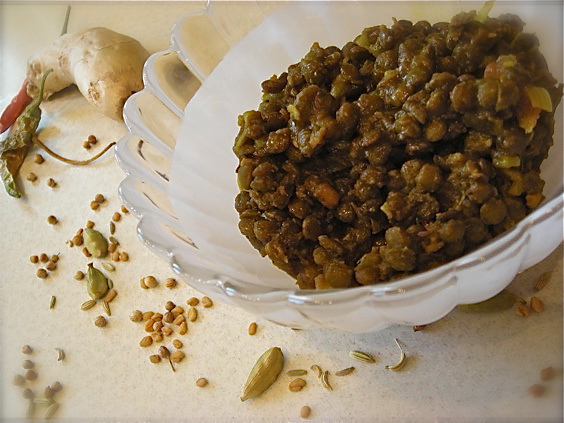
One of these days, maybe.
Dhal with Green Lentils
adapted slightly from The Curry Book by Nancy McDermott
1 c. french puy green lentils, rinsed and sorted
4-5 c. water
1 t. ground turmeric
1 t. fenugreek seeds, crushed
1/2 t. ground cayenne
2 t. cumin seeds
3 cloves finely minced garlic
2 T. finely minced fresh ginger
1 medium onion, finely minced
1 medium tomato, chopped
In a large saucepan, bring 4 cups of the water and lentils to a boil. Skim off any foam that may form. Reduce heat to medium-low and add the turmeric, fenugreek and cayenne. Allow to simmer, uncovered, until lentils are tender- approximately 25-35 minutes. You may need to add more water as the lentils cook to prevent them from sticking.
When lentils are tender, heat a small skillet over medium heat with oil of choice. Add the cumin seeds and cook until they become dark and fragrant, and begin to pop. Add in the onion, garlic and ginger and reduce the heat, sauteing gently and stirring occasionally until the vegetables are soft, about 5-7 minutes. Stir the mixture into the lentils and blend well. If the lentils are soupy, you can raise the heat and simmer the mixture to reduce the liquid. Keep an eye on it so it doesn’t burn and stir it to keep blended. When cooked to your desired consistency, stir in the tomato. It will thicken slightly as it stands. Season with salt if desired.
NOTE: It’s unlikely you can find fenugreek in anything other than seed form. To crush them, use a dedicated spice grinder if you have one, or place them in a sealed plastic bag and crush them with a rolling pin, a meat tenderizer or other hard implement. The seeds are pretty solid. Don’t be surprised if doing it by hand requires slight effort. It’s totally worth it for the flavor.
This dish definitely gets better with some time to sit in the fridge. It can be made with the smaller colored lentils but keep in mind that the cooking time will be much quicker, and it will have a different texture. One cup of red lentils will need less water, about 3-4 cups.
November 21st, 2009
| 3 Comments »
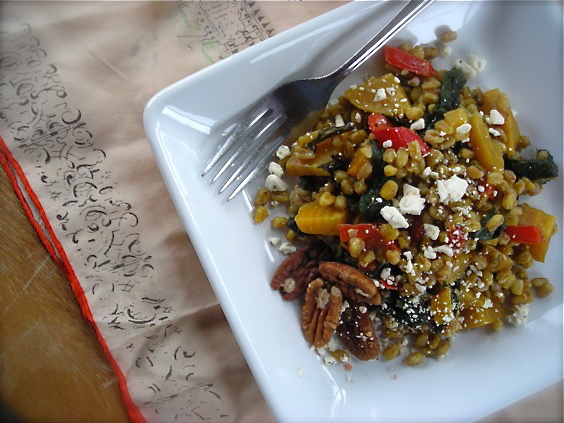 
Pictures can be amazing, can’t they?
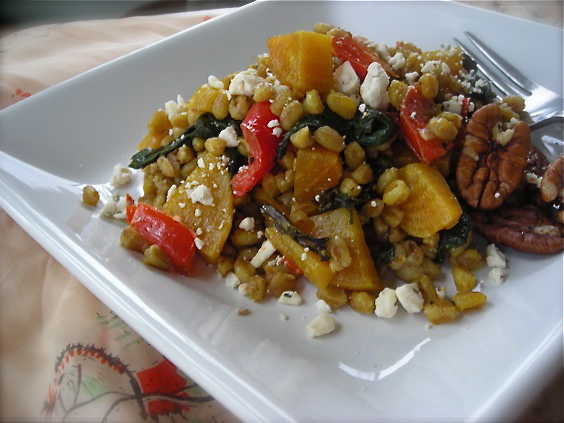
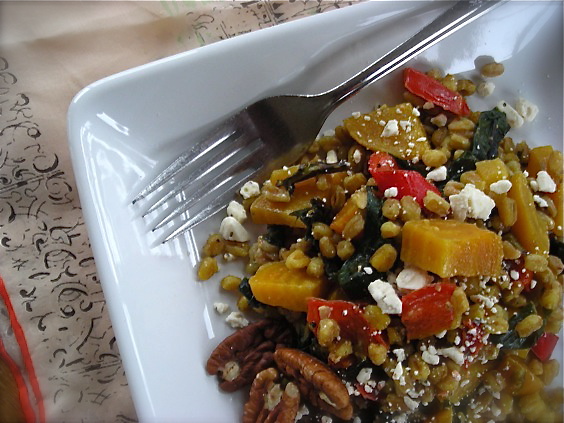
I sometimes surprise myself when I am going through the photos I’ve taken of my recipes. There are, without a doubt, the ones that hastily cause you to hit the ‘Delete’ key, shuddering in horror; they’re too close or too cloudy or they just don’t allow for one to discern what’s on the plate. They’re overexposed. Ugly. But those tiny slips caught in the wink of the shutter are evened out by beauties that can convey taste, aroma, and feel with one glance. The beauties that make you go ‘Wow’ and when you place them in your post, they literally tell the story without you needing to do much else. But every food has a story. Sometimes the tale tells of a feet-first plunge headlong into love with a certain food, a single bite causing your taste-buds to explode while the endorphins engulf your brain. You’re whupped and there’s no going back. Or it may be a telling of how we find a food that quietly asserts itself into our life, a slow and deliberate culinary courtship. Maybe the first exposure isn’t mind-blowing, but it isn’t a dud either. You look forward to the next time. You know there’s more to it than this. After a few meetings, the quiver in your heart starts to build and when you spy your current food crush, it’s silly how your chest seems to collapse in relief that you’ll be together again.
This past year I crushed, big time, into total infatuation with gold beets, and their greens. It didn’t take much. By routinely visiting the organic farmer at the local markets who carried these burnished lovelies and allowing them to roast to their full potential, I became fully acquainted with their earthy solid personality. We just clicked, those beets and I. It was quality time well spent. Mike gave me an enthusiastic endorsement for sauteed beet greens and we never looked back. Beets were in the recipe box, finally. We ate them so much that it was a turgid and satiated overkill. We sighed a lot during those dinner meals. Then high summer came, the corn took hold along with eggplants so shiny and purple, followed by a parade of tomatoes and zucchini and endless grilling adventures. Beets were nearly forgotten, sad as it was. But I was sold on the roasting method, and most days couldn’t even consider turning on the oven. They simply had to wait. I realized after a while that I missed them a great deal but I knew, like any solid friendship, that we would endure through our separation.
Then I found this recipe. It was the way back to my summer love of beets and caused me to drive across town just to find a bunch, greens attached, that would do this recipe justice. The moment we connected again was like any friendship renewed after absence. No lapse of time could remove the bond and the oven, once more, shared it’s warmth with my old friends and turned them soft and supple.
I was enamored…no, scratch that… bewitched by the flavors that came from this dish. It’s simple base of whole grain farro is more than capable of standing up to the lusty flavor and texture of beets and their greens, and the beets happily share their colors with the grain to diffuse the entire dish in sunshine-y warmth. Since 2007 I’ve been experimenting with whole grains, and I found farro to be an amicable and easy friend to bring into my life, a chewy and simple grain that mimics wheatberries and a heartier barley. Never mind that it was costly. Or that only one store I knew carried an affordable brand. Of all the whole grains I’ve encountered in the past two years, this one has become a good and trusted companion, steadfast, reliable and so so good for me. We all need friends like that in our lives, in both our hearts and our pantry.
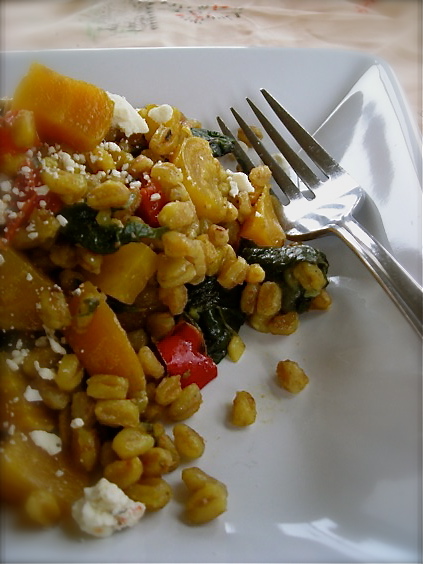
The original recipe for this dish was in salad form, but for a November meal, a cold offering wasn’t going to cut it. Even with the warm sunshine that’s been poured upon us, the chill and darkness comes quickly with the descent of the five-o’clock hour, and something steaming, whether a bowl or a plate, more appropriately fits the season. I’ll revisit the salad option next Spring when the markets open again, and I can once more hone in on that stand, with the kind bearded farmer behind the table, the dirt still stuck to his knuckles. For this time of year, and especially with the brisk wind that came up after several days of that limpid sunshine, a pilaf was exactly what we needed.
Farro is not a quick grain to cook, and you’ll find many recipes call for it to be soaked ahead of time, but I’ve discovered that to be unnecessary. Washed and placed in boiling water, the grain cooks up deliciously chewy in 35-45 minutes, and once cooked to that al denté stage, it freezes really well with little loss of texture. And maybe it’s the way it is with you too, but I roast my beets or I simply don’t eat them. Call me picky, but I never met a beet I wanted to devour before being introduced to those that mellowed in the oven, swaddled in foil, and so perfectly tender that the skins slipped off with hardly any effort. Again, this isn’t quick. I made both the farro and the beets the day prior to creating this pilaf. It worked for all of us.
Farro Pilaf with Gold Beets
originally from The New York Times recipes for Health and Nutrition, March 27, 2009; adapted by Kate
3 large gold beets, roasted and diced, with greens washed, de-ribbed and rough chopped
2-3 c. cooked farro (can sub brown rice)
1 red pepper, seeded, cored and diced
2 garlic cloves, minced
1 small shallot, diced
1/2 c. crumbled feta or goat cheese
1/3 c. pecan pieces
salt and pepper to taste
{{Farro can be cooked like any other grain, with a 2:1 ratio of water to grain; 1 cup uncooked will yield the amount needed for this recipe. It should be tender to the bite, not too firm with a texture similar to barley. Be sure to rinse it thoroughly in a wire sieve prior to cooking. It can be very dusty.}}
In a deep skillet with a tight fitting lid, heat oil of choice and add red pepper, cooking for about 5 minutes. Add shallot, cooking until soft and slightly browned, maybe 5-8 more minutes. Add garlic and cook until fragrant, 30 seconds or so. Add the chopped greens and cook, stirring continually until just barely wilted. Stir in the cooked farro and diced beets. Add about 1/3 cup of water and combine. Cover the pot, turn heat to low and cook, stirring occasionally until heated fully through. Season to taste with salt and pepper. Serve topped with cheese and nuts.
KATE’S NOTES:
The mellow flavors of the beets and farro simply beg for a good salty and robust cheese. Feta is perfect, goat cheese would be great but blue cheese and gorgonzola also would work nicely.
September 30th, 2009
| 12 Comments »

You’re not a potato, my chalky tuber. You are not even really considered a yam, by the true means of the word. But to avoid confusion and misunderstanding, you are required to carry the moniker ‘Sweet Potato’. You are golden, bright orange, pale yellow and the color of a sunrise, at once starchy and dry, as well as moist and tender. You make amazing oven fries, stunning side dishes, distinct risottos and perfect pies. You have that multiple personality trait down to a science, don’t you? Who would have thought that you were distantly related to gorgeous Morning Glory flowers? And aren’t you the healthy one? Rich in antioxidants like beta carotene and Vitamin A, complex carbs and fiber, you rank awfully high on the nutritional value chart, giving us iron and calcium to boot. Oprah is a big fan of you, lucky spud. That pretty much guarantees you’ll be the talk of the town, doesn’t it? We can come by you quite inexpensively too, although no one can call you cheap- you are a class act, my friend. You hold up well to storage too. And thankfully, you are in great supply, for our demand for you is high and you’re readily available all year round. And if we choose to cook you, mash you and store you in the freezer, you never complain. And patiently you wait for us to bring you back out and make something wonderful from you.
Like these muffins. Thanks for offering up all your golden glory to a humble breakfast and snack food.

You and I, though, we haven’t always been friends, and I’m sorry I ignored you all those years. Think of the fun we would have had! But no matter. We’re tight now, and that’s all that counts. I love it hanging out with you, and am so glad I introduced you to my good pal oatmeal. The two of you make quite a pair in this delicious and stout muffin, don’t you?

I’m not at all jealous that you get along so well, in fact, I really like it when my friends find something good about each other, something they enjoy that has little to do with me. I was happy to introduce you two; it seems to be a match made in heaven, and how easy is it to get you two to hang out? Really, it takes little effort, and for my gain I get delightful and simple muffins that speak poetically of Fall, warm with cinnamon and nutmeg and the hearty toothsome bite of whole oats. Not to mention that sweet tender tang of you, my tuberous pal. I’m so glad I gave you more than a passing glance. We’re great friends for life, yes we are.
Oh by the way, have you met another good friend of mine, her name is sweet cream butter?
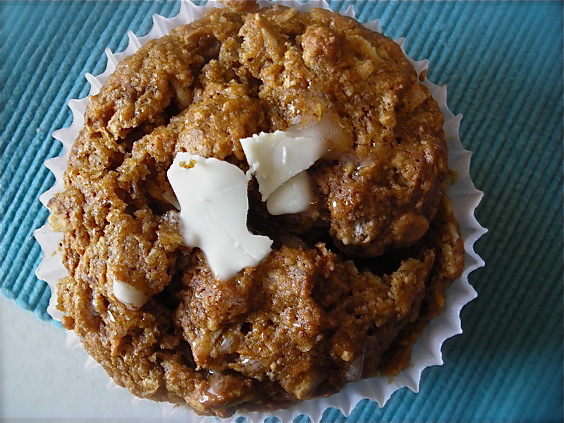
Oatmeal Sweet Potato Muffins
from the Louisiana Sweet Potato Commission
1 c. old fashioned rolled oats
1 c. flour (AP or Whole Wheat, or both)
1 t. baking powder
1/2 t. baking soda
1 t. ground cinnamon
1/2 t. ground nutmeg
1 T. ground flaxseed
1 c. cooked and mashed sweet potato
3/4 c. brown sugar
1/3 c. canola oil
1/4 c. skim milk
1 large egg
1 t. pure vanilla extract
Preheat oven to 400°. Line two standard muffin tins with paper liners.
In a medium bowl, whisk oatmeal, flour, baking powder and soda, cinnamon, nutmeg and flaxseed. In another small bowl, combine sweet potato, brown sugar, oil, egg, milk and vanilla, whisking to blend well. Pour over dry ingredients and stir to combine. Mix until just moistened. Scoop into muffin tins and back for 15-20 minutes. Check at the 15 minute mark- these bake up quickly.
KATE’S NOTES:
This recipe doubles really easily. I doubled it using both AP and whole wheat flour and the result was nice and firm. You can substitute pumpkin for the sweet potato, or use garnet yams. Be sure that the vegetable is cooked and mashed well. I used soy milk in mine and it works just fine. For one batch of these, I added 1/2 c. of flaked coconut, and I think chopped and toasted pecans would be wonderful in these.
For an extra level of flavor, you can top these with a crumb topping made from 1/4 c. oats, 1/4 c. flour, 1/4 c. brown sugar, 1-2 T. softened butter and 1 t. vanilla extract. Combine these well and sprinkle over the muffins before baking. I have not used it, but imagine it would be excellent.
April 22nd, 2009
| 2 Comments »
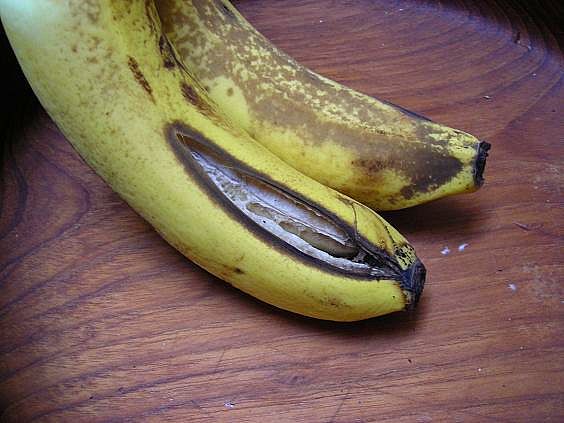 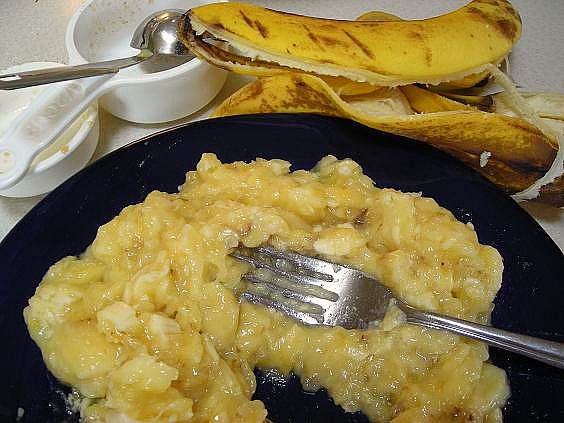 
Banana Bran Muffins
Mix in bowl until blended:
1 1/2 c. buttermilk
2 large eggs
2 T. butter, melted
1/3 c. unsweetened applesauce
Add in 1 1/2 c. All Bran cereal and 1/2 c. whole oats; stir to combine. Allow to sit for 15 minutes, stirring occasionally.
Mash two ripe bananas on a plate and set aside.
In separate bowl, sift together:
3/4 c. AP flour
3/4 c. whole wheat flour
1/4 c. brown sugar
1 t. EACH baking powder and baking soda
1/4 t. salt
2 T. ground flax seed
Gently stir the bananas into the milk/bran mixture. Combine the wet ingredients with the dry and fold gently to incorporate. Do not overmix. Scoop into muffin tins lined with paper cups (or sprayed) and bake at 375° for 20-25 minutes, or until tops are springy. Cool on wire rack.
KATE’S NOTES:
Regular milk, or soy milk can be subbed for buttermilk. To make buttermilk (or sour milk) mix one teaspoon vinegar or lemon juice per cup of regular milk. Stir to combine and allow to sit until curdled. Plain or vanilla yogurt can also be used- stir about 1 cup of yogurt with half a cup of water.
This recipe is wonderful with frozen or fresh blueberries. Toss one cup of fresh washed berries with a tablespoon of flour to keep them from sinking. For using frozen blueberries, gently fold them in, undrained and unrinsed, after you incorporate the wet and dry ingredients. Lemon zest is particularly nice with a blueberry addition; use about a teaspoon or two, with an additional 2 tablespoons of juice as well. Shredded apples also make a nice fruit substitution. Core and shred about two small tart apples and add to wet ingredients. You can stir in a half cup of extra applesauce with the wet ingredients, or even use apple butter (same proportion) for more flavor.
April 16th, 2009
| 3 Comments »
I think everyone is trying to eat better for their health, and subsequently, their pocketbooks. Information abounds in money-saving tips, grocery shopping tactics and ‘Quick! Fast! Cheap!’ meals are everywhere.
I’m thrilled that Springtime, and the return of fresh produce is commencing. It changes the whole tone of what happens in my kitchen, and on our plates. There are sweet baby lettuces that need barely a gasp of fresh squeezed lime juice and a tiny drizzle of balsamic, rich asparagus stems in a quick sputtering stir-fry and tiny crisp radishes dredged through a bit of french sea salt. I keep dreaming about main-dish salads of smoky grilled vegetables. I long for summer cherries, melon season and corn plucked from the field that morning, dew still clinging to the leaves and tassels. It can’t come soon enough. I long to retire my soup pot and clean out the oven; bye bye rutabagas, thick skinned squashes and heavy braises. Nights may still need those extra blankets, but this girl’s in the mood for new food.
I’ve started to move a little from winter’s heavier fare to quicker, simpler and more varied eating, mostly by fulfilling my current hankering for anything cabbage related. This isn’t the most spring-like of offerings, but it’s cheap, chock full of excellent nutrition and it keeps like a trooper in the fridge when properly wrapped. I’ve been a fan of cabbage since I was a little girl. It was one of my Mom’s continual offerings. She would chop up an entire head of green cabbage, place it in the ‘cabbage tupperware’ (reserved only for that use) and then pour on some Good Seasons Italian dressing and grate a bunch of pepper over it. The cover would be pressed into place and she would shake that thing like crazy. I can still hear the sound of all that cabbage being tossed around. Cabbage makes me think of her and I still love it with little else besides that same dressing, doctored in my own fashion, tossed with a handful of chopped almonds for crunch and extra flavor, although there’s far more to this humble vegetable than most people ever realize.

Cruciferous vegetables-like broccoli, cauliflower, cabbage, and kale-are rich in a variety of compounds that have been shown to slow cancer growth and development in a number of laboratory studies. Other larger human studies have shown that cruciferous vegetables can help to reduce the risk of lung, stomach, colorectal, prostate, and bladder cancers. (from the Living Strong Living Well website article ’11 Cancer Fighting Foods)
Cole slaw is a very favorite dish of mine as well, only I am not one to beam and shout over most recipes, drenched as they are in a mayo based dressing to the point of giving the term ‘limp and soggy’ a run for its money. Although that tastes pretty darn good on a pulled pork sandwich, from the end of a fork it doesn’t resonate quite so beautifully. Coleslaw needs to be made and eaten quickly. It’s one food where ‘leftovers’ in my fridge tend to cause immense shuddering and a wrinkled nose.
The whole idea of coleslaw has changed dramatically in my mind, thanks to the endless food blogs that pour out every variation of the stuff. It isn’t just about the cabbage anymore, and by definition, if it adds something more, is it still just humble coleslaw?
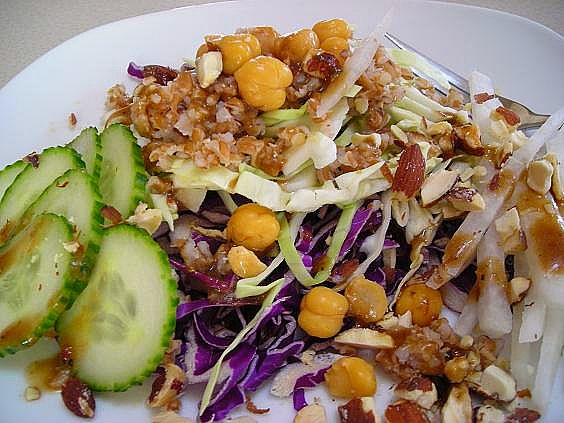 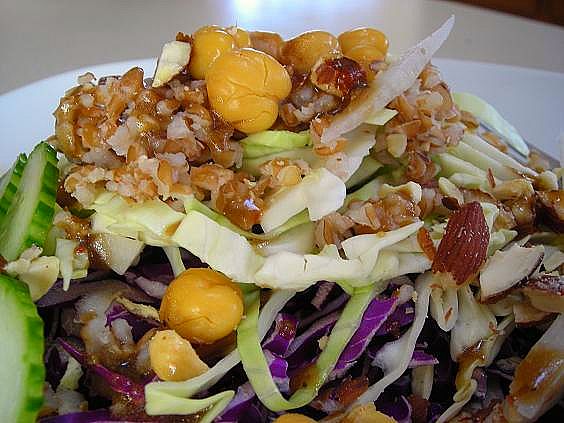
This recipe evolved from several sources and plenty of inspiration. It mixes green and red cabbage, jicama sticks, garbanzo beans, cooked bulgur and chopped almonds, with a few cool cucumber slices on the side for color and crunch and in return, it promises you a plate of superb antioxidant protection, a powerhouse of vitamin C, omega-3 fats, whole grain goodness and loads of crunch. It sticks with you long after the fact too, with an amazing amount of fiber that leaves you feeling satisfied and full without being too overbearing. No one needs food to continually outstay its welcome; these days we want a good meal without wishing for a sofa and pillow afterwards. And it’s so good that it won’t take long for you to turn a lovely pile of vegetable goodness into a near bare and heavily appreciated empty plate.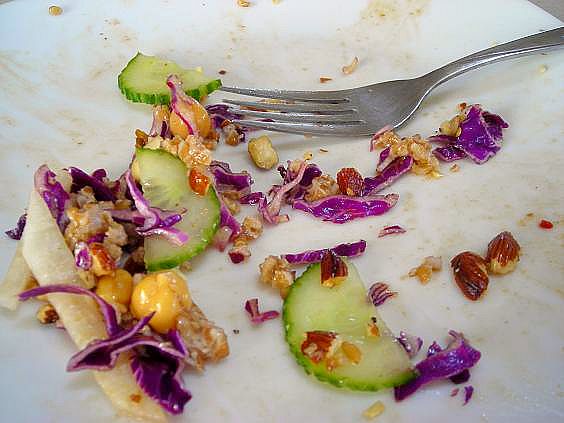
This is also a perfect offering for the blogging event happening over at Mele Cotte- Cooking to Combat Cancer. Chris is now in Year Three of being cancer- free and calling all food bloggers to offer up recipes with cancer-fighting appeal.

There is no shortage of good people around me fighting with everything that they have against the ravages of cancer, and this event can help everyone arm themselves with good tools to put in their pantries and tummies that will offer some support to a body that is constantly exposed to an wide range of harmful properties. I owe an enormous amount of my well-being and overall health to the foods that I eat; whole foods, plenty of vegetables and fruits, lean meats, whole grains, nuts; it’s all there. I stepped up my efforts to make our meals even better over the winter, and we were rewarded with only a smattering of illness that took little time to disperse. While food itself isn’t the only way to stay healthy, it’s one good tool you can use to help your body be at it’s very best.
Super Slaw Salad
by Kate
1/4 head of both red and green cabbage, shredded or chopped
1/2 can garbanzo beans, drained and rinsed
1/2 c. cooked bulger
1/2 c. (approx.) of thinly sliced jicama
1/4 c. chopped almonds
Cucumber slices
Dressing of choice
Combine all ingredients in large bowl and toss to mix, adding dressing to taste and seasoning with fresh cracked pepper or a dusting of good sea salt. Allow to sit for 15 minutes to allow flavors to blend.
KATE’S NOTES:
Obviously, endless variations on this abound. It’s almost silly to make a cut and dried recipe out of it. I would have added carrots if I had some. Shredded apple would be delicious. I love the addition of shredded bok choy and napa cabbages to my slaws also. Vary the dressings too for a different flavor profile, like an asian style with sesame seeds. Change up the nuts, the beans or the grain.
March 25th, 2009
| 5 Comments »
I am one of those cooks who use recipes only as a fundamental guideline to a finished product. I can trust my own cooking skills enough, and what I know about how my family eats, to be confident when I look at a recipe in determining what ingredients in it won’t work, or what needs to be enhanced. Even simple basic products can be made better with a little creativity and an eye towards a higher nutritional value.
Take a jar of spaghetti sauce. It’s high on the convenience scale, and has a reasonable amount of nutritional value, provided you avoid the sugar-laden brands and stick with a purer variety. With the addition of sauteed onion and garlic, along with shredded zucchini, carrot and spinach, a few chopped fresh roma tomatoes, some fresh basil or rosemary and a little tomato paste to bring it all together, you get a pasta sauce brimming with vegeteble content, better flavor and more nutrition.
I often come across recipes too, that when I do follow them to the letter and get that anticipatory excitement of what the finished product will be, I often end up sorely disappointed, especially if I ignore my inner urgings to add something of my own liking. It is a rare occurence indeed when I work through a recipe and come to a conclusion, after following the prescribed steps, that what I see in front of me might be way better than what the original end result offered. That was the case with this Savory Millet Risotto.
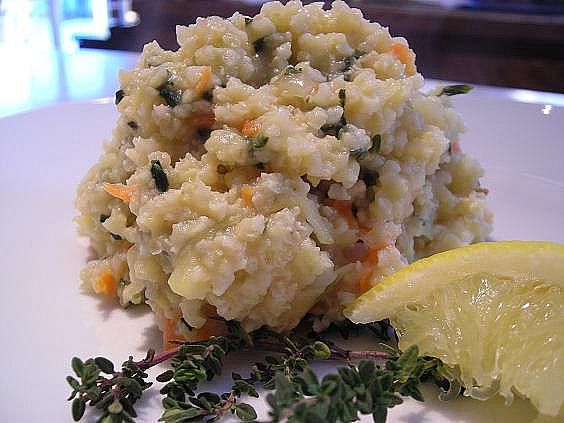
The recipe, from the current issue of Eating Well magazine, was supposed to be for a Millet Cake, similar in structure and use to Polenta. Even though I have given up on using Polenta in any of my meals after repeated attempts to enjoy it always fell flat, I earmarked this recipe as an option. The millet cooks with shredded vegetables, parmesan cheese, fresh thyme and lemon zest to a creamy consistency, at which point it would be cooled, then shaped into patties to sear in a pan. It never made it that far.
Come in to my kitchen…
January 8th, 2009
| 6 Comments »
Not long ago, I spoke about taking baby steps towards chickpea appreciation.
I’m getting there. Slowly.
And also slowly, I’m foraging into my cookbook cupboard and removing a few under-appreciated and under-utilized books; books that hold glorious recipes that make me drop my head back on the chair in a sort of agony, due to my tastebuds sorrow over never having tried it, and how delicious does this look anyway?? And why do I have this book with the almost perfect spine and unstained pages? These bitter days of January, bright with sunlight and diamond sparkling snow are perfect for experimentation, for exploring the vast untapped knowledge in these books. Now that I am getting my cross country skis out regularly, it gives me a much needed energy boost and all that drive needs to go somewhere, doesn’t it? Best get cooking, I say.
Well, hello there beautiful…..
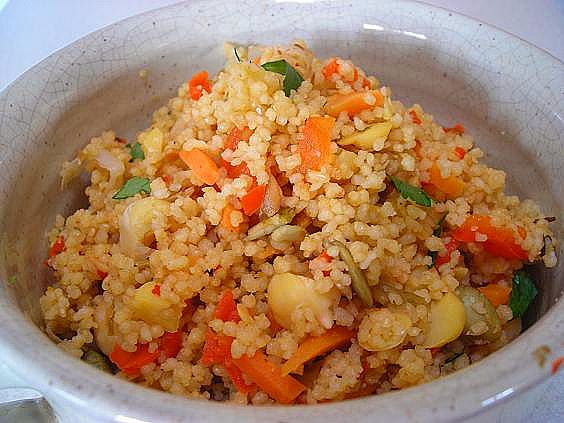
Couscous is about as much fun to say as it is to work with; what other product can you dump in boiling water and forget about, coming back to tender tiny little grains of perfection with zero fuss? What else can be fixed so quickly that you barely have time to chop up a few nuts, or grate some good asiago to mix into it for a stellar side dish? Let’s say couscous….. Cous…..cous.
And this dish turned out gorgeous, if I do say so myself. Brightly colored pepper and carrot nestled up to the rich green of cilantro and with a quick toss of chili garlic sauce, it became just a tiny breath of spice in the mouth, nothing 4-alarm, not a rush of sweat breaking on the brow but just a hint of the heady flavor of chilies. It’s like when you eat something and it evokes a memory that you can’t quite place. Fleeting. Perfect.
Yes, the chickpeas. Right.
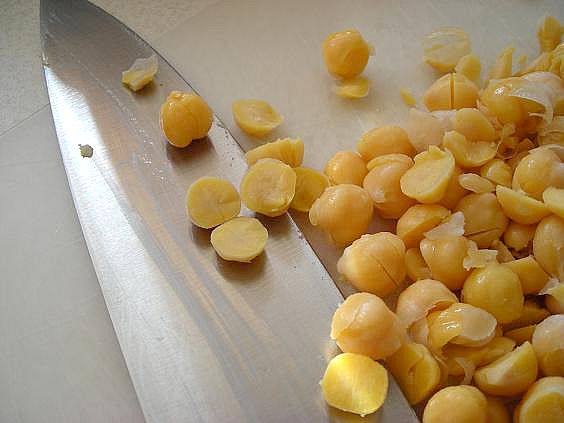
I liked the idea of mixing the chickpeas in the all that couscous goodness, the vegetables and bite of chili sauce, but I thought ‘Hey, y’know, they aren’t the right size!’ because it’s all about symmetry in my world- the towels folded edge to edge, the sheets and comforter hanging to the same length on both sides of the bed- symmetry, similar and even. Besides, when faced with a plate of food, especially something like this, it’s all about the teeny-weeny (it is couscous, after all) and so I blended the pepper and carrot in the food processor to mince them fine, whacked the nuts to pieces and took my chef knife to the chickpeas.
I then turned my kitchen into The Flying Chickpea Circus. Did I think at all that those little guys might be quite sprightly?
Oh, and the skins. Ew. That never occurred to me as I lifted my Wustof. I don’t like those skins. But it was time for chin up, marching forward to the finish line. Think symmetry; ignore the skins.

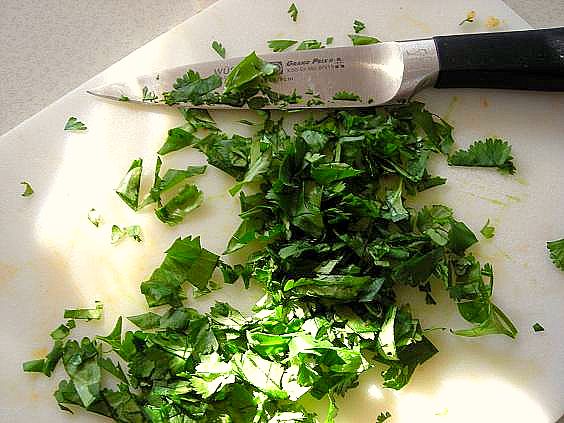
In real time this only took about 15 minutes to pull together, of course, minus the chickpea chasing. I had the vegetables seared and waiting, the cilantro chopped, the nuts fragrant and toasted. A few quick tosses and my fork was present and accounted for, heading to my mouth. So delightful. I think the best part of this dish came later, at dinnertime, as I sat down to a steaming bowl of soup I realized that I wasn’t even that hungry. My small bowl of grains, legumes and vegetables had given me some serious sustenance, a bonus to any recipe.
More chickpea appreciation and a great dish to boot; this works perfectly as a good main course or as a side dish. Increase the chili garlic sauce for your own heat level. Watch for the flying chickpeas.
Spicy Couscous and Chickpeas
The Food and Mood Cookbook by Elizabeth Somer and Jeanette Williams.
1/2 c. chopped pepitas
2 c. chicken broth
2 c. whole wheat couscous
2 t. olive oil
1 medium red bell pepper, stemmed seeded and diced
1 medium carrot, peeled and diced
1 15-oz can chickpeas, rinsed well
1-3 T. chili garlic sauce
Fresh chopped cilantro
Toast pepitas in a hot skillet until fragrant, remove to dish. In same skillet, saute pepper and carrot in oil until soft, about 5 minutes. Set aside. Bring broth to a boil, add couscous and stir, then cover and remove from heat to absorb. In large bowl, combine couscous, chickpeas, pepper, carrot, pepitas and chili garlic sauce. Salt if desired. Top with cilantro.
KATE’S NOTES:
In the original recipe, the nuts listed are slivered almonds, which would be delicious in this. Toast them as well. The original recipe did not call for carrot, but it definitely improves the overall appearance and nutrition of the dish. Whole wheat couscous was my addition and I think the heartier flavor of the grain is a real boon. Thin the chili garlic sauce with a little water to make mixing more uniform. I subbed cilantro for parsley as I like it better.
|





























